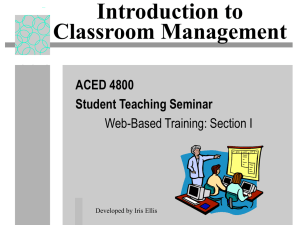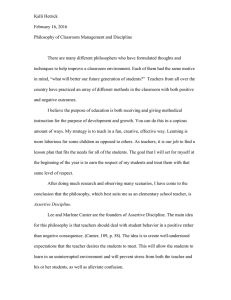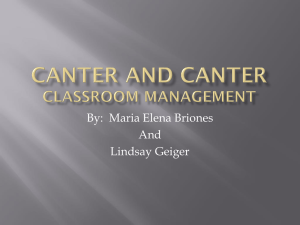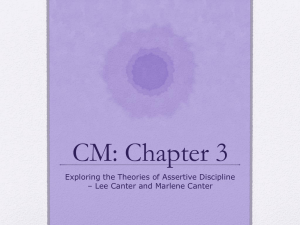Classroom Management
advertisement
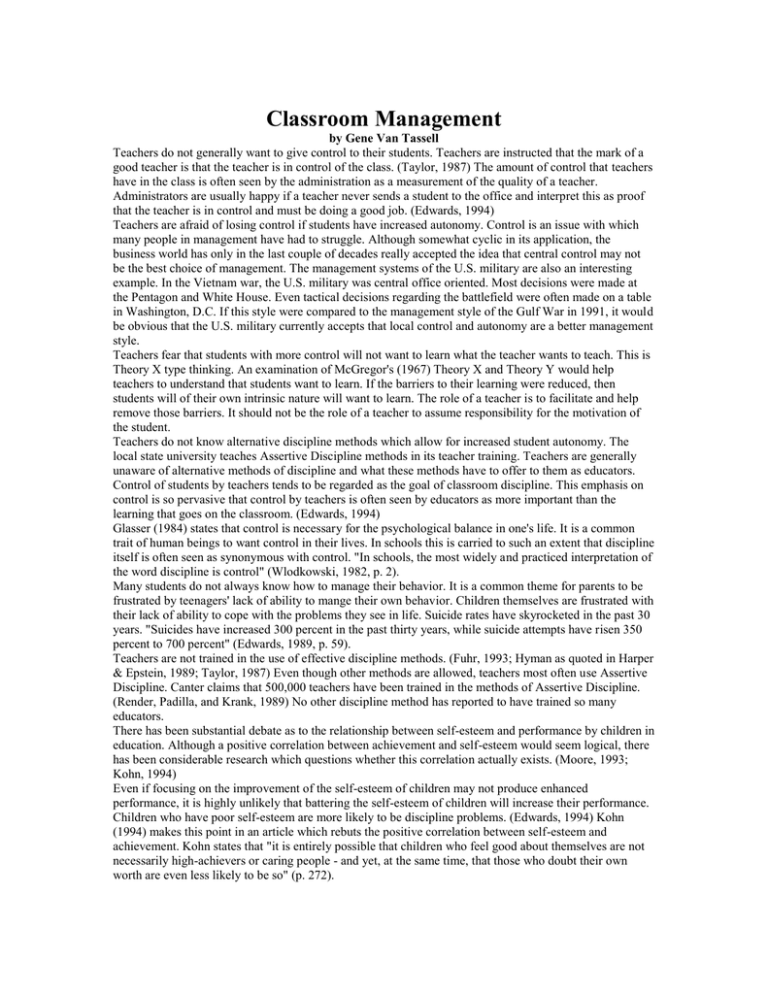
Classroom Management by Gene Van Tassell Teachers do not generally want to give control to their students. Teachers are instructed that the mark of a good teacher is that the teacher is in control of the class. (Taylor, 1987) The amount of control that teachers have in the class is often seen by the administration as a measurement of the quality of a teacher. Administrators are usually happy if a teacher never sends a student to the office and interpret this as proof that the teacher is in control and must be doing a good job. (Edwards, 1994) Teachers are afraid of losing control if students have increased autonomy. Control is an issue with which many people in management have had to struggle. Although somewhat cyclic in its application, the business world has only in the last couple of decades really accepted the idea that central control may not be the best choice of management. The management systems of the U.S. military are also an interesting example. In the Vietnam war, the U.S. military was central office oriented. Most decisions were made at the Pentagon and White House. Even tactical decisions regarding the battlefield were often made on a table in Washington, D.C. If this style were compared to the management style of the Gulf War in 1991, it would be obvious that the U.S. military currently accepts that local control and autonomy are a better management style. Teachers fear that students with more control will not want to learn what the teacher wants to teach. This is Theory X type thinking. An examination of McGregor's (1967) Theory X and Theory Y would help teachers to understand that students want to learn. If the barriers to their learning were reduced, then students will of their own intrinsic nature will want to learn. The role of a teacher is to facilitate and help remove those barriers. It should not be the role of a teacher to assume responsibility for the motivation of the student. Teachers do not know alternative discipline methods which allow for increased student autonomy. The local state university teaches Assertive Discipline methods in its teacher training. Teachers are generally unaware of alternative methods of discipline and what these methods have to offer to them as educators. Control of students by teachers tends to be regarded as the goal of classroom discipline. This emphasis on control is so pervasive that control by teachers is often seen by educators as more important than the learning that goes on the classroom. (Edwards, 1994) Glasser (1984) states that control is necessary for the psychological balance in one's life. It is a common trait of human beings to want control in their lives. In schools this is carried to such an extent that discipline itself is often seen as synonymous with control. "In schools, the most widely and practiced interpretation of the word discipline is control" (Wlodkowski, 1982, p. 2). Many students do not always know how to manage their behavior. It is a common theme for parents to be frustrated by teenagers' lack of ability to mange their own behavior. Children themselves are frustrated with their lack of ability to cope with the problems they see in life. Suicide rates have skyrocketed in the past 30 years. "Suicides have increased 300 percent in the past thirty years, while suicide attempts have risen 350 percent to 700 percent" (Edwards, 1989, p. 59). Teachers are not trained in the use of effective discipline methods. (Fuhr, 1993; Hyman as quoted in Harper & Epstein, 1989; Taylor, 1987) Even though other methods are allowed, teachers most often use Assertive Discipline. Canter claims that 500,000 teachers have been trained in the methods of Assertive Discipline. (Render, Padilla, and Krank, 1989) No other discipline method has reported to have trained so many educators. There has been substantial debate as to the relationship between self-esteem and performance by children in education. Although a positive correlation between achievement and self-esteem would seem logical, there has been considerable research which questions whether this correlation actually exists. (Moore, 1993; Kohn, 1994) Even if focusing on the improvement of the self-esteem of children may not produce enhanced performance, it is highly unlikely that battering the self-esteem of children will increase their performance. Children who have poor self-esteem are more likely to be discipline problems. (Edwards, 1994) Kohn (1994) makes this point in an article which rebuts the positive correlation between self-esteem and achievement. Kohn states that "it is entirely possible that children who feel good about themselves are not necessarily high-achievers or caring people - and yet, at the same time, that those who doubt their own worth are even less likely to be so" (p. 272). The fear and stigma of public punishment must not be underestimated. I have asked persons 60 to 70years-old to recollect school experiences. The majority of those memories are negative ones--punishments handed out by teachers in front of children a half century before. I feel for the shy first grader who always will remember her name on the board for something that was not her fault or should have been ignored. (Gartrell, 1987, p. 10) There are many stories of how discipline used incorrectly can have lasting negative effects on the lives of children. (Harper & Epstein, 1989) It is difficult to argue that these are positive influences on the education of a child. Children need to be provided with an education in an environment which does not destroy their self-esteem. Discipline is widely regarded by most educators and the public alike as the number one problem in schools. (Wlodkowski, 1982) Even though administrators and teachers alike view discipline as their number one problem, newly graduated teachers still feel woefully unprepared for the task awaiting them when they start their first teaching job. (Taylor, 1987) There is a plethora of opinions on classroom discipline and systems available from which to choose. ASSERTIVE DISCIPLINE The discipline system known as Assertive Discipline was developed by Lee and Marlene Canter in 1976. In the first 12 years of distribution "Lee and Marlene Canter claim to have trained some 300,000 teachers in workshops in 48 states -- including half of the teachers in Oregon and California" (Crockenberg, 1982, p. 59). By 1989, some 500,000 teachers had been trained in Assertive Discipline. (Render, Padilla, and Krank, 1989) No other discipline system has made such claims of distribution and acceptance. Assertive Discipline teaches students to accept the consequences of their actions. It has "as its basic premise the reinforcement of appropriate behavior" (Render, Padilla, and Krank, 1989, p. 609). "Responsibility is exactly what Assertive Discipline is all about" (Canter, 1988, p. 24). Practitioners of Assertive Discipline are taught that they must learn to be assertive in taking control of the class. A system of rewards and punishments are devised by the teacher to let students know when they have acted correctly or incorrectly. Increasingly unpleasant penalties are incurred by students who continue to make improper choices. Canter expresses concern about teachers who "spend too much time punishing children. . . . This is the key to Assertive Discipline, positives and lots of praise" (Canter, 1988, p. 24). Assertive Discipline is generally considered easy to learn. "Assertive Discipline provides an attractive, packaged, simple-to-understand, easy-to-implement alternative" (Curwin and Mendler, 1989, p. 83). Assertive Discipline seems to be the easiest discipline system to implement. (Emmer, 1986; Edwards, 1993) Teachers will often feel secure in implementing Assertive Discipline with only a few hours of training in a seminar behind them. (Curwin and Mendler, 1989; Emmer, 1986; Edwards, 1993) There are many criticisms of Assertive Discipline. There has been limited research on the effectiveness of such a widely accepted discipline system. (Curwin and Mendler, 1989) "We found only 16 studies (10 dissertations, 3 journals, and 3 other reports) meeting our criteria. Equally surprising is the nature of the studies. Not one study systematically investigated the program's effectiveness compared with any other specific approach" (Render, Padilla, and Krank, 1989, p. 72). Although Assertive Discipline is widely used, there are many arguments that suggest it does more harm than good. (Watson, 1982; Crockenberg, 1982; Curwin and Mendler, 1989; Gartrell, 1987) The self-esteem of students is often decreased by methods born of Assertive Discipline. "Excessive control is apparently a major contributing factor in creating at-risk conditions for school children" (Edwards, 1994, p. 344). Assertive Discipline is also criticized on the basis that it suggests that all problems in a classroom stem from students who do not know how to behave. (Curwin and Mendler, 1989) "The Canters nowhere in their book recognize that behavior problems in the classroom might possibly be a function of poor teaching" (Crockenberg, 1982, p. 63). Students are forced to accept the rule of the teacher or else. Lines of control are strictly enforced with little or no democracy in the classroom. It is up to the teacher to make and enforce classroom rules. "The teacher knows what is required. . . . Parents must adapt to the teacher's requirements. Any attempts by parents to criticize teaching are understood to be 'side-tracking manipulations', uninformed and unfair" (Crockenberg, 1982, p. 63). Hitz (1988) describes Assertive Discipline as "power assertion rather than developing responsible behavior" (p. 25). THEORY X AND THEORY Y Theory X and Theory Y is an example of non-Newtonian thinking. McGregor (1967) is not talking about two different types of people, but two different ways in which people can be viewed. Theory X is Newtonian, Theory Y is post-Newtonian. Theory X suggests that people will the do the minimum possible amount of work necessary to accomplish a task. Theory X suggests that enticement is required through deterministic techniques to get people to do what the enticer wants them to do. Theory Y suggests that all people want to succeed, but there are obstacles in their path which inhibit their progress. If these obstacles are removed, then they can succeed as well as anyone else. McGregor (1967) states, "Strictly speaking, the answer to the question mangers so often ask of behavioral scientists-How do you motivate people?--is: You don't. Man is by nature motivated" (p. 10). This approach suggests a holistic approach to solutions. Theory Y suggests that the process is more important than the deterministic motivations that come from behaviorism. Theory Y promotes autonomy, while Theory X simply pushes people to prescribed goals. Gartrell (1987) suggests that Assertive Discipline punishes children "for having a problem rather than being helped to resolve that problem" (p. 10). This example suggests a Theory X view of children by Assertive Discipline. According to the post-Newtonian paradigm, looking at the process is more important than trying to predict behavior. It is the process of overcoming obstacles that is important. With effort and work focused on the obstacles, educators will be working on the relationship of a spectrum of barriers rather than trying to predict individual behavior. This understanding of a post-Newtonian paradigm helps educators to understand why Theory Y may be the more acceptable method of viewing individuals and the solutions to their problems. CONTROL THEORY Control theory was developed by William Glasser in 1984. Glasser subsequently developed Reality Therapy in 1989. Glasser (1984) suggests that there are 4 basic human needs. They are love, control, freedom, and fun. These four components are necessary for a healthy psychological balance. Children need to be taught how to control their behavior. People have pictures in their head of their perception of the world. These pictures include perceptions of their needs and how they can be satisfied. "Most people, however, do not believe they have a choice" (Glasser, 1989, p. 2). It is the responsibility of a teacher to teach students that students choose how they act. "The teacher's task is to help students make good choices by making clear the connection between student behavior and its consequences" (Emmer, 1986, p. 7). Glasser emphasizes that people do not picture themselves doing badly. Everyone has a view of being successful and happy. Individuals may at times choose to do self-destructive things, but do not intend to destroy themselves. Pictures make sense to people; otherwise, they would not have them. (Edwards, 1993) Reality Therapy is a series of steps to help children understand the choices they are making. A teacher first tries to help the student identify the inappropriate behavior of the student. Then the teacher helps the student identify the consequences of that behavior. No attempt is made to come up with new or artificial consequences that the teacher might impose. It is important that the student, not the teacher, identify the consequences. Then the student needs to create a plan to eliminate inappropriate behavior. The teacher helps the student with successful implementation of the plan or allows the consequences to occur. (Edwards, 1993) Problems reported with Control Theory and Reality Therapy are that it takes considerable training and classroom time to implement these programs. (Edwards, 1993) Emmer (1986) reports that "all of the studies of Reality Therapy that assessed effects on student variables . . . showed at least one student outcome that differed significantly for the E [Experimental] and C [Control] groups or from pre to post" (p. 15). Control Theory is a relatively new theory which fits outside of the Newtonian paradigm. Glasser (1993) states, "Control Theory is a new explanation of how we choose to live our lives: It is actually a new psychology" (p. 122). Glasser's Control Theory suggests that one of the criteria that makes us psychologically healthy is possessing control in our life. Having autonomy as a student increases the control and self-esteem in a student's life. Students having autonomy in the classroom is at odds with the behaviorism of Skinner. Skinner's behaviorism which stems from the Newtonian paradigm suggests that people can be controlled by applying the correct rewards and punishments. According to Glasser (1989), pushing a student into a corner until they conform with our expectations is not in accordance with a psychologically healthy adolescent. When youth turn 18, society expects them to make rational, complex decisions, yet behaviorism has its major emphasis on compliance as opposed to the development of cognitive skills. There is a need to look at the process of acquiring those skills as opposed to concentrating on activities with predictive consequences. BEHAVIORISM Much of the movement that is seen in education today stems from the desire to be scientific according to Newton. Behavior Modification by Skinner is one of molding all children to conform by use of standard punishments and rewards. Prediction is an important part of Skinner's work. Behavior Modification techniques suggest that specific rewards and punishments will yield predictable results in the behavior of children. Behaviorism suggests a system that will modify children to comply with prescribed norms. Compliance with these prescribed norms restricts student autonomy. As would be expected in the Newtonian paradigm, the theory is to predict results by detailing correct initial conditions and equations that prescribe action upon those initial conditions. In the case of Skinner behaviorism, the initial conditions are individuals and the equations are those behavioristic techniques set out to modify the individuals. It is true when the behavioral sciences have gone beyond the collection of facts to recommend courses of action and have done so by predicting consequences, they have not been too helpful . . . Applied psychology is usually a mixture of science and common sense. . . . From the very beginning the application of an experimental analysis of behavior was different. It was doubly concerned with consequences. (Skinner, 1976, p.viii) Canter describes Assertive Discipline as teaching students the natural consequences of their actions. "Students choose [consequences]. Assertive teachers do not punish students. Students are taught to accept the consequences for their own actions" (Canter, 1988, p. 24). The Newtonian model of standard conditions giving predictable results is apparent. Bracey (1994) states that "15 years of research have confirmed that offering a reward for an enjoyable behavior can decrease the likelihood that the behavior will be performed under subsequent nonrewarded conditions" (p. 494). In the name of being scientific like Newton, educators impose Assertive Discipline on children. Skinner's behaviorism and Canter's Assertive Discipline are attempts by one of the social sciences, psychology, to imitate the Newtonian paradigm. Quality should be defined in nonmathematical terms. It is not the score on a test which defines student success. The goal in classrooms should be that the students want to learn more and feel good about what they do in the classroom. (Glasser, 1993) In this respect, it is not what is taught, but how it is taught that is significant. As transformational leaders are concerned about the form of the future, educators should be concerned about a wider view of education than a Dow Jones Index for Education. (Guthrie, 1993) Classroom management techniques are an important focus point. Educators need to develop a vision for their classroom based on modern principles. Too many teachers substitute the management of the Newtonian paradigm for the leadership of the post- Newtonian paradigm. A vision of a perfect classroom has less room for managers, but lots of room for leaders. The objective of leadership is to provide vision to students, as opposed to managers who demand compliance. (Bennis, 1992) TRANSACTIONAL ANALYSIS Transactional analysis studies the interactions of behavior between teachers and students. (Harris, 1967) Harris suggests three stages of development called ego-states. These ego-states are called Child, Parent, and Adult. In order for teachers to be successful in transactional analysis, they need to remain in the Adult egostate and be able to recognize the ego-state of students around them. Teachers can then recognize the games that students may play in a Child ego-state and teach students to behave in an Adult ego-state. The strengths of this approach are that students are encouraged to monitor their own communication and behavior. The disadvantages of this system is that it may be too difficult for students and cause them to psychoanalyze each other. (Edwards, 1993) GINOTT MODEL The Ginott Model concentrates on the communication between teacher and student. This approach concentrates on avoiding criticism and trying to understand the student's feelings. Teachers are encouraged to foster student autonomy and try to help students take responsibility for their actions. These goals are accomplished by establishing a communication with the students and by reasoning with the student. (Edwards, 1993) Kay Model The Kay Model views the character of children built upon internalized standards. People constantly judge their actions by these internal standards. By teaching and building upon these internal standards, children can be taught to by self-governing and responsible for their own actions. Students are intrinsically motivated to behave properly if they are taught how to do it. Students are responsible for their own motivation and for monitoring their own behavior. Teachers should not lift these responsibilities off of the students' shoulders. The role of the teacher is to teach students how to monitor themselves. (Kay & Kay, 1994) JONES MODEL Fredric H. Jones developed a model of classroom discipline which accentuated the physical presence of the teacher. The basic assumptions of the Jones Model are that children need to be controlled and that teachers can achieve this control through body language, administration, and parental support. A teacher needs to understand stage presence. The ripple effects of the teacher's presence will go out and affect each student if the teacher adequately forceful. Stopping instruction, staring, sitting close to the student are all powerful intimidation techniques which should stop students from misbehaving. (Edwards, 1993) RECOMMENDATIONS 1. Training in discipline techniques is needed by any teacher. Many teachers know little or nothing of nonbehavioristic discipline techniques and are generally thrilled to hear about alternative methods. 2. Non-behavioristic discipline techniques need to be taught to teachers more than once. These techniques are the most difficult for teachers to grasp and to be comfortable applying in the classroom. 3. Teachers must role play Reality Therapy many times in a learning environment such as a seminar before they can apply this method in the classroom. Although teachers may choose this as their favorite method, teachers may not be successful in its application without sufficient practice. 4. Classroom management is an ongoing process which is unlikely to be learned in a single seminar. Given that many discipline seminars are only a day long, such a short seminar may not give all the information needed for teachers to make a education decision regarding classroom discipline techniques. SUMMARY Too often, studying the structure of a system focuses on what makes that structure stable. Prigogine and Stenger's (1984) work on dynamic systems showed that disequilibrium is necessary for growth. It is not the structure that is important, but the process of where the system is moving. (Wheatley, 1994) Bennis (1985) suggests that leaders (a) have a vision of where they want to go, (b) must communicate this vision to those around them, (c) position themselves where they can be effective, and (d) have the courage to leave their comfort zones and walk a tightrope to where they want to go. Note that Bennis is talking about the process of detailing that a process is moving somewhere, rather than about the structure that is being created. Since early history, society has been influenced by its vision of science. It has only been a few decades since the Newtonian paradigm lost its hold on science. It is not surprising that those areas of study that have been fashioned on the anvil of the Newtonian paradigm are still pursuing that paradigm headlong, even though the physical sciences have now moved in a new direction of relativity, quantum mechanics, and chaos theory. It is important to understand that a new fundamental understanding of our universe has occurred. It is still unclear as to where the new science paradigm will lead. It is not yet fully developed. A similar analogy might be imagining the world in Europe in 1544. Many people wondered where this new theory about the earth revolving around the sun might lead them. Much more progress will be made by making the right assumptions now as well as then. New theories are being proposed from the social sciences which support and corroborate the new science. Classroom discipline methods are not immune to this examination. New and old theories alike need to be evaluated in light of their dependence on the Newtonian paradigm. These evaluations can lead to greater success and understanding in determining what will be effective in the management and leadership of children in classrooms. Control theory, Reality therapy, Theory X, and Theory Y are examples of organizational behavior theories of the post-industrial model which promote student autonomy. Behavioristic techniques worry about what the structure looks like rather than where the process is leading. home page References Bennis, W.G., & Nanus, B. (1985). Leaders: The strategies of taking charge. New York: Harper Perennial. Bennis, W.G. (1992). Managing the dream: Leadership in the 21st Century. In W. E. Rosenbach & R. L. Taylor (Eds.), Contemporary issues in leadership (3rd ed., pp. 213-218). Boulder, CO: Westview. Bracey, G. W. (1994). Reward and punishment. Phi Delta Kappan, 75, (6), 494-497. A call for higher standards and stricter discipline in schools. (1993, May). Money, 22, 35. Canter, L. (1988). Assertive discipline and the search for the perfect classroom. Young Children, 43(2), 24. Canter, L. (1988). Let the educator beware: A response to Curwin and Mendler. Educational Leadership, 46(2), 71-73. Crockenberg, V. (1982). Assertive discipline: A dissent. California Journal of Teacher Eduction, 9(4), 5974. Curwin, R. L. & Mendler, A.N. (1989) We repeat, let the buyer beware: A response to Canter. Educational Leadership, 46,(6), 83. Edwards, C. (1989). Self-regulation: The key to motivating at-risk children. The Clearing House, 63(2), 5962. Edwards, C. (1993). Classroom discipline and management. New York: Macmillan College. Edwards, D. (1993). Making choices about discipline. American Secondary Education, 22(2), 17-21. Edwards, C. (1994). Learning and control in the classroom. Journal of Instructional Psychology, 21(4), 340-346. Emmer, E.T. (1986). Effects of teacher training in disciplinary approaches. Washington, DC: U.S. Department of Education, Office of Educational Research and Improvement. (ERIC Document Reproduction Service No. ED 316 927) Fuhr, D. (1993). Effective classroom discipline: Advice for educators. National Association of Secondary School Principals Bulletin, 76(549) 82-86. Gartrell, D. (1987). Assertive discipline: Unhealthy for children and other living things. Young Children, 42(2), 10-11. Glasser, W. (1984). Control theory. New York: Harper and Row. Glasser, W. (1989). Control theory in the practice of reality therapy. New York: Harper & Row. Glasser, W. (1993). The quality school teacher. New York: HarperCollins. Guthrie, J.W. (1993). Do America's schools need a 'Dow Jones Index'? Phi Delta Kappan, (74), (7), 523529. Harper, S. & Epstein, J. (1989). Corporal punishment in schools. Malibu, CA: National School Safety Center. (ERIC Document Reproduction Service No. ED 310 535) Harris, T.A. (1967). I'm OK--You're OK. New York: Avon Books. Hitz, R. (1988). Assertive discipline: A response to Lee Canter. Young Children, 43(2), 25-26. Kay, R. S. & Kay, D. S. (1994). The best is within them: Propositions, principles and strategies for teaching respect, responsibility, and excellence in the classroom. Unpublished manuscript. Kohn, A. (1994). The truth about self-esteem. Phi Delta Kappan, 76(4), 272-283. McGregor, D. (1967). The professional manager. New York: McGraw-Hill. Moore, R. (1993). Grades and self-esteem. American Biology Teacher, 55(7), 388-9. Prigogine, I. & Stengers, I. (1984). Order out of chaos. New York: Bantam. Render, G., Padilla, J., & Krank, H. (1989) Assertive discipline: A critical review and analysis. Teachers College Record, 90(4), 607-630. Render, G., Padilla, J., & Krank, H. (1989) What research really shows about assertive discipline. Educational Leadership, 46,(6), 72-75. Skinner, B.F. (1976). Walden two. New York: MacMillan. Taylor, B.W. (1987). Classroom discipline: A system for getting the school administrator to see classroom discipline problems your way. Dayton, OH: Souther Hills Press. Watson, M., (1982) Classroom control: To what ends? At what price? California Journal of Teacher Education, 9(4), 75-91. Wheatley, M. J. (1994). Leadership and the new science: Learning about organization from an orderly universe. San Francisco: Berrett-Koehler. Wlodkowski, R.J. (1982). Discipline: The great false hope. Unpublished manuscript, University of Wisconsin-Milwaukee. (ERIC Document Reproduction Service No. ED 224 782)
